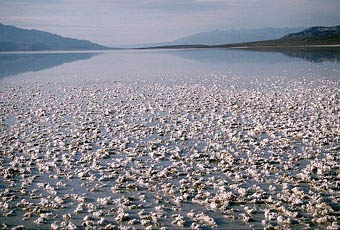Ever wondered how rocks are made? First off, there are three different kinds of rocks, Igneous, Sedimentary, and Metamorphic. Each rock is formed in different ways.
Lava from a volcano cooling and solidifying into Igneous rock.
Sedimentary rock is rock that is formed by the compaction and cementation of deposited sediment on earths surface, especially on the bottom of oceans and rivers. As the river erodes mountains, it carries lots of different size sediment with it, including large rocks, gravel, sand, and silt. When the river reaches the ocean, most of the larger sediments have already been deposited farther upstream, so the smaller sediments such as sand, silt, and clay, get deposited on the sea floor or in the delta of the river. Overtime, these sediments pile up, compacting each other, and minerals from the water cement them together in the layers that characterize sedimentary rock. Later, if that ocean disappears because of subduction or drifting continents, the mountains of sedimentary rock on the ocean floor gets exposed. We see so much of it today because New York used to be a sea. Sedimentary rocks are evidence of erosion because the sediments that make up the rock come from deposition of eroded sediments from mountains.
These cliffs show clear evidence of sedimentary rock and erosion and deposition.
The last type of rock is Metamorphic. Metamorphic rocks form from heat and pressure deep under the earth's surface. When any kind of rock, including Metamorphic, gets pushed deep under the earth's surface by any force(subduction, drifting continents, earthquakes), they are subject to extreme pressure from all the plates pushing against each other. Also, the closer the rock is to the mantle, the more heat affects it. When rocks are under extreme heat and pressure, the rock may change it's texture, crystal structure, and mineral content. When a rock changes because of these forces, it becomes a Metamorphic rock. Metamorphic rocks are classified by the arrangements of grains that make up the rock - Foliated or Non-Foliated. Some examples of Metamorphic rocks are Marble, Slate, and Gneiss
The above Metamorphic rock's layers were created by extreme heat and pressure under the earth's crust.
The Rock Cycle

This diagram shows how different kinds of rocks can be transformed into one another and what forces cause them to do so.
Click here to better understand the rock cycle!
Clastic Sedimentary rocks form when a bunch of fragments from other broken rocks get compressed together and cemented. These rock pieces can be large boulders or microscopic particles of clay. First, rock sediments get deposited on the floor of a river or ocean. Then, as more layer accumulate, the pressure of all the layers compacts the sediments. Finally, minerals from the water and the rock seeps into the holes between the sediments and cements it all together, creating Clastic Sedimentary Rock.
Shale is a type of Clastic rock that forms when clay piles up in thin flat layers. No cementation is needed to hold the particles together, and the holes are too small to let any water through them. Conglomerate, on the other hand, is made of many rounded pebbles and sand cemented together.
Shale(left) vs. Conglomerate(right)
Organic Sedimentary rock is made of when the dead organic material piles up in swamps or oceans, and over time, the minerals and buildup of that material turn into organic sedimentary rock. For example, Limestone forms when remains of the hard shells of living animals from a coral reef pile up and compact over the weight of more and more layers. Some of the shells dissolve into calcite, which cements all the layers together to form Limestone. Chalk is a type of Limestone.

In this Limestone you can see the remains of tiny shelled creatures.
Finally, chemical Sedimentary rock is formed when dissolved minerals, in a lake for example, crystallize. When this happens with dissolved calcite it creates chemical Limestone. Chemical Sedimentary rocks can also form when there are mineral deposits in a lake or sea, and the lake evaporates, leaving the minerals to harden and crystallize. Gypsum is an example of a chemical Sedimentary rock formed by evaporation.

Rock salt is a chemical Sedimentary rock. These chemical rock formations are left as this lake evaporates.
Another example of chemical Sedimentary rock.
Thanks for reading my post! - TommY











